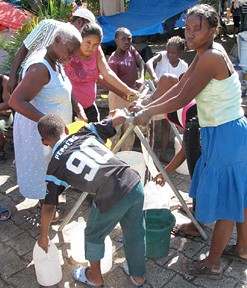WASH Cluster System Works, UNICEF and DINEPA Lead Disaster Relief Effort

Trevor White's bags were packed. As a water, sanitation, and hygiene (WASH) technical advisor for the Office of U.S. Foreign Disaster Assistance (OFDA) of the United States Agency for International Development (USAID), he was to be in Zimbabwe on January 14. Then, on January 12th, a 7.0 earthquake hit the country with the least access to improved water and sanitation in the Western Hemisphere. Five days later, Trevor was in Haiti.
"Port-au-Prince was in chaos," he reported. "The port was devastated; the airport was affected. Everything had to be set up from scratch. Haiti was an urban disaster. All responders were working 20 hour days under serious stress."
The quake's 230,000 death toll included 17 percent of Haiti's federal work force. Sixty percent of Port-au-Prince's buildings were leveled, including 28 of 29 government buildings, along with computers, vehicles, phones, and other infrastructure. More than 1.5 million displaced people had no immediate access to safe drinking water or a toilet, and were at risk from sanitation- and water-related diseases.
In 2005, after seeing the response to the 2004 Southeast Asia tsunami disaster, the United Nations established a "cluster system" approach to coordinate disaster response around the world specifically by sectors such as WASH, shelter, health, and nutrition. UNICEF was tasked to lead Haiti's WASH earthquake cluster. In 2009, Haiti established La Direction Nationale d'Eau Potable et d'Assainissement [National Directorate for Water Supply and Sanitation] (DINEPA), a government regulatory authority that had begun to reform Haiti's water and sanitation system, which had been operating at a budget deficit and providing questionable water. DINEPA, like USAID/OFDA, is part of Haiti's WASH cluster. DINEPA, established just nine months earlier, immediately took charge and, with UNICEF, began to co-lead the WASH response.
"DINEPA tested wells and approved three good sources," Trevor continued. "Within two or three days, they had established a fleet of privately owned chlorinated water tankers, fuel reserves, and a delivery system.
"At first," he said, "trucks just had to park and deliver water - an inefficient process. Soon after, non-governmental organizations (NGOs) had set up water bladders and tap stands in most of the largest camps. When I visited those camps, the water bladders were full and there was no one in queues - a good sign that water was in supply. There were few complaints about water. Camp residents primarily asked about food and jobs. If a water delivery system had not been established so early, things could have gone very differently.
"This was an international emergency WASH response success," Trevor added. "No other sector in Haiti had a government department leading a cluster. I saw DINEPA create an environment of cooperation - and save lives."
Jay Graham, a USAID environmental health advisor, echoed that sentiment. Jay first arrived in Haiti in February. He is encouraging USAID/Haiti to use transformative efforts to empower DINEPA to complete the reform and to capacity-build with other large donors.
"DINEPA's personnel are very committed," Jay remarked. "You can tell from their prior work in Haiti's poorest communities, and because they are asking NGOs to help this group especially," he added. "I was surprised. You hear that the cluster system doesn't work. Here is a WASH cluster response that is effective. The cluster works fast; test results show improved water quality; DINEPA places water quality test results and other data on-line; they are transparent, sensitive to requests from stakeholders, open to criticism and NGO challenge, and forthright about sharing contacts. DINEPA and UNICEF give each stakeholder a chance to speak at cluster meetings, and they encourage Haitians to participate in
the meetings."
To date, USAID/OFDA has given $30.2 million in funding to support emergency WASH activities in Haiti. In addition, USAID/OFDA has donated 11 water purification units; 106,592 hygiene kits; 166,600 10-liter water containers; 30,000 bottles of water; 22 water bladders; and 20 desludging trucks, used to empty latrines.
At a July 19 USAID media roundtable event, Haiti Task Team Coordinator, Paul Wiesenfeld said, "...we feel pretty good about the immediate humanitarian response. When I say we, I really speak for the international community because the United States was [only] one player in it."
Trevor agreed. "It is all those relationships and history with organizations and with DINEPA that enables us to work well together, that enables us to know how we all work, that brings about our success. One donor does not do it all. It is all a puzzle that is solved by having good relationships with other donors, NGOs, governments, and with those affected. It is important to see this as a holistic approach."
Trevor's first trip to Haiti lasted five weeks; he has returned four times. Of leaving Haiti, he laments, "Well, of course you don't want to leave. There is so much to do."
Trevor hopes to travel to Zimbabwe this fall.







Comment
Make a general inquiry or suggest an improvement.